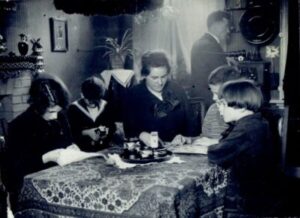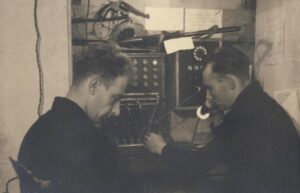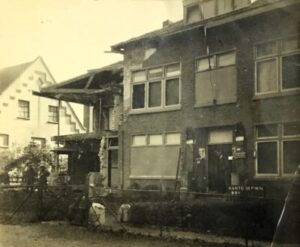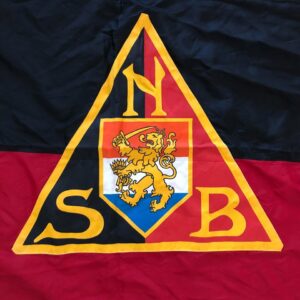Pommerel, Wilhelmus Hendricus, born 20-03-1894, in Amsterdam, Geldezooijweg 19, now nr 49.  the son of Willem George Pommerel and Engelina Hendrica Maria, born Moozeker.
the son of Willem George Pommerel and Engelina Hendrica Maria, born Moozeker. 
 Wilhelmus was married to Anna Maria Roovers.
Wilhelmus was married to Anna Maria Roovers.
The Pommerel family around 1940, from left to right: Engelien, Wim Sr., Cor, Wim Jr., Anna, and Nellie (photo: Pommerel family). Son Cor  was also in the resistance and worked as a postal worker at the secret telephone exchange and listening center Post Poddie. Cor Pommerel was a member of the resistance group Post Poddie in Hoorn, Netherlands,
was also in the resistance and worked as a postal worker at the secret telephone exchange and listening center Post Poddie. Cor Pommerel was a member of the resistance group Post Poddie in Hoorn, Netherlands,  during World War II, where he assisted his brother Wim Pommerel
during World War II, where he assisted his brother Wim Pommerel  in connecting illegal phone lines to the PTT exchange, enabling them to eavesdrop on German conversations. Wim Pommerel, a resistance fighter, was eventually arrested, tortured, and shot by the Germans in a reprisal action.
in connecting illegal phone lines to the PTT exchange, enabling them to eavesdrop on German conversations. Wim Pommerel, a resistance fighter, was eventually arrested, tortured, and shot by the Germans in a reprisal action.
Wilhelmus was a Inspector 2nd Class, of the Provincial Electricity Company of North Holland. Roman Catholic. Resistance member belonging to the OD (Objective) Order Service and the Dutch Resistance. Among other things, he laid illegal telephone lines for the resistance, as well as power supplies for radio and listening posts. Wilhelmus also facilitated illegal press activities.
The Order Service was established at the beginning of the war by (former) soldiers to be able to intervene and maintain order in the Netherlands after the expected departure of the Germans. When the occupiers remained, the OD developed into a key force within the resistance. The Internal Forces (Binnenlandse Strijdkrachten)  was officially established on 05-09-1944, with the aim of uniting the resistance groups that had sprung up throughout the country.
was officially established on 05-09-1944, with the aim of uniting the resistance groups that had sprung up throughout the country.
The resistance held its meetings at Wim’s home in Hoorn. The inspector’s residence at the Provincial Electricity Company of North Holland (PEN) was located next to the combined office of PEN and PWN (Water Supply). The address of the residence at the time was Geldelozeweg 19 in Hoorn. Next to the office stood a large water tower. During the war, on 04-10-1944, a bomb fell on the office, narrowly missing the house next to it to the right (not visible). 
Until something went terribly wrong in early 1945. Wim’s secret phone number was on a list held by secret agent Tobias Biallosterski  (resistance name: Hans). This “Hans” had been dropped into the Netherlands by the Bureau of Special Assignments on behalf of the Allies to organize the resistance in North Holland. On 10-02-1945, Biallosterski was arrested in Wognum. Members of the Landwacht (Dutch Land Guard)
(resistance name: Hans). This “Hans” had been dropped into the Netherlands by the Bureau of Special Assignments on behalf of the Allies to organize the resistance in North Holland. On 10-02-1945, Biallosterski was arrested in Wognum. Members of the Landwacht (Dutch Land Guard)  and traitors were ordered to call all the numbers on Hans’s phone list to see if they could identify a voice. The Dutch Landwacht was a volunteer auxiliary police unit of (armed) NSB
and traitors were ordered to call all the numbers on Hans’s phone list to see if they could identify a voice. The Dutch Landwacht was a volunteer auxiliary police unit of (armed) NSB  members. The NSB (National Socialist Movement), under the command of Anton Adrian “Ad” Mussert,
members. The NSB (National Socialist Movement), under the command of Anton Adrian “Ad” Mussert, 

 is a Dutch fascist political party founded in 1931. In the Netherlands, as in other countries, unemployment and poverty are high. The NSB’s supporters hope for a better future with a single, strong party and a single leader. During a check by the Grüne Polizei and the Landwacht on 10-02-1945, on Zomerdijk in Obdam, Biallosterski was arrested along with four other men. Wearing English flying boots, he immediately stood out. The detainees were taken to the town hall in Obdam for questioning. At the station, he attacked both guards. In the ensuing scuffle, he was seriously wounded by a fired bullet. Two weeks later, Tobias succumbed to his injuries in the Scheveningen prison
is a Dutch fascist political party founded in 1931. In the Netherlands, as in other countries, unemployment and poverty are high. The NSB’s supporters hope for a better future with a single, strong party and a single leader. During a check by the Grüne Polizei and the Landwacht on 10-02-1945, on Zomerdijk in Obdam, Biallosterski was arrested along with four other men. Wearing English flying boots, he immediately stood out. The detainees were taken to the town hall in Obdam for questioning. At the station, he attacked both guards. In the ensuing scuffle, he was seriously wounded by a fired bullet. Two weeks later, Tobias succumbed to his injuries in the Scheveningen prison  at the age 24 on 26-02-1945.
at the age 24 on 26-02-1945.
Death and buriasl ground of Pommerel, Wilhelmus Hendricus.


Three days after Biallosterski’s arrest, Wim Pommerel was apprehended by members of the Landwacht in Hoorn. After being imprisoned in Alkmaar and Amsterdam, he was executed by the Germans along the provincial road from Limmen to Uitgeest on 06-04-1945, age 51, along with nine others. His body was temporarily buried in the Kennemerduinen. Later he was buried at the Overveen Cemetery of Honor.
The Limmen firing squad took place one day after the resistance had failed—and possibly even unnecessary—to attack two German soldiers, in which one of the two was killed; the other managed to escape.
By the end of July 1945, the remains of 422 people had been found in 45 burial pits at six locations in the dunes; 105 had been murdered in the dunes, the remaining 317 elsewhere in North Holland. Under the supervision of the National Security Bureau, the victims were identified as best they could. A difficult task, both physically and mentally. The bodies were not coffins. Many were in an advanced state of decomposition.
Resistance fighters, not even yet tried, were held as “Todeskandidaten” (death candidates) to be executed in reprisals. The Germans had even established a system for this. For every Dutch traitor killed, five resistance fighters were executed, and for every German killed, ten. Acts of sabotage were also met with executions. In North Holland, near Sint Pancras, there were even twenty casualties when a Zaan resistance group, against the wishes of the local resistance fighters, blew up a railway bridge there on 15-04-1945, to prevent the supply of German reinforcements to Texel (a Georgian uprising).

















Leave a Reply